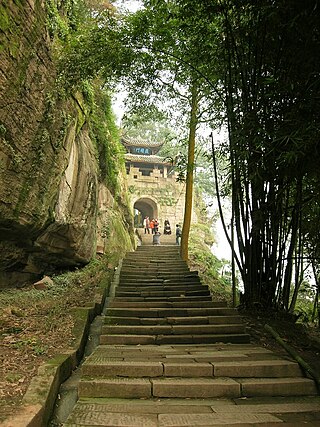
Hanzhong is a prefecture-level city in the southwest of Shaanxi province, China, bordering the provinces of Sichuan to the south and Gansu to the west.
James Shoal is a reef (bank) in the South China Sea, with a depth of 22 metres (72 ft) below the surface of the sea, located about 45 nautical miles off the Borneo coast of Malaysia. It is claimed by Malaysia, the People's Republic of China, and the Republic of China (Taiwan). The reef and its surrounds are administered by Malaysia.

Cimei Township is a rural township in Penghu County, Taiwan. The island is the fifth largest in the Pescadores (Penghu) and the southernmost island in the group. It is the smallest township in Penghu County.

Longwu was the era name of the Longwu Emperor of the Southern Ming. It was used for 2 years. On 24 December 1646, after the Yongli Emperor ascended to the throne, he continued to use this era name, and the following year, the era was changed to Yongli.

The Da Ming Hunyi Tu is an extensive Chinese map. It was painted in colour on stiff silk and 386 x 456 cm in size. The original text was written in Classical Chinese, but on the surviving copy Manchu labels were later superimposed. The surviving copy of the map shows later revisions, and it is uncertain whether it is the original.

The Shanhai Yudi Quantu is a Ming dynasty Chinese map published in 1609 in the leishu encyclopedia Sancai Tuhui.

Jack C.K. Teng, was a Chinese educator, writer, politician, diplomat and Olympic pioneer. He is best known as the Chairman of the Chinese National Olympic Committee during the 1960 Summer Olympics, the first time a Chinese athlete won an Olympic medal.

Dadan Island is an island in Lieyu Township, Kinmen County, Fujian Province, Republic of China (Taiwan). The island is in the Taiwan Strait, along the coast of Mainland China. It is located approximately 12,000 m (7.5 mi) to the southwest of Lesser Kinmen (Lieyu) and approximately 4,400 m (14,400 ft) from Xiamen (Amoy).
The Yu Gong or Tribute of Yu is a chapter of the Book of Xia (夏書/夏书) section of the Book of Documents, one of the Five Classics of ancient Chinese literature. The chapter describes the legendary Yu the Great and the provinces of his time. Most modern scholars believe it was written in the fifth century BCE or later.
The Waxiang people are an unrecognized ethnic group living along the Yuan River in Yuanling County of western Hunan, China. They call themselves Huaxiang people and they speak Waxiang Chinese. Compared to the Han, Miao and Tujia people of the region, they are very different in terms of clothing, food, living, farming and other cultural norms.

Erdan Island is an island in Lieyu Township, Kinmen County (Quemoy), Taiwan. The island has been called Seao-tan. Erdan Island is 12 km (7.5 mi) from Greater Kinmen Island and 4 km (2.5 mi) from Xiamen (Amoy) Island.

Dongji Island / Dongji Islet / Tungchi Island is an island in Dongji Village, Wangan Township, Penghu County, Taiwan. Dongji Island has also been known as Nandongyu (南東嶼).

Dayuling, formerly Hehuan Pass, is a mountain pass in Taiwan transversing the Central Mountain Range between Hehuanshan and Mt. Bilu (畢祿山), within Taroko National Park. Administratively, it is located in Xiulin, Hualien County near the border with Nantou County.

The Sichuan anti-Mongol fortresses are 83 mountain cities built by the soldiers and civilians of the Southern Song Dynasty during the Mongol conquest of China in Sichuan to resist the invasion of the Mongol Empire. Taking full advantage of the geographical advantages of the Sichuan Basin, these fortresses formed a comprehensive three-dimensional defense system, which succeeded in resisting the Mongol attacks for up to 53 years, greatly extending the life of Southern Song. They also made Sichuan the last to be conquered by the Mongolians in 1288. Due to the defense of the fortresses, it was difficult to settle the Sichuan region. The Mongol Army had to abort its original strategy of "taking Shu (Sichuan) and destroying Song" and moved to the area of Jingzhou and Xiangyang starting from 1271, defeating the Song Dynasty via the Han River. Möngke Khan became the only Mongol khagan to perish on the battlefield when he died during an assault on Diaoyucheng in 1259. He may have been a victim of dysentery or of injuries sustained when attacking the fortress.

The debate on the "Chineseness" of the Yuan and Qing dynasties is concerned with whether the Mongol-led Yuan dynasty (1271–1368) and the Manchu-led Qing dynasty (1636–1912) can be considered "Chinese dynasties", and whether they were representative of "China" during the respective historical periods. The debate, albeit historiographical in nature, has political implications. Mainstream academia and successive governments of China, including the imperial governments of the Yuan and Qing dynasties, have maintained the view that they were "Chinese" and representative of "China". In short, the cause of the controversy stems from the dispute in interpreting the relationship between the two concepts of "Han Chinese" and "China", because although the Chinese government recognizes 56 ethnic groups in China and the Han have a more open view of the Yuan and Qing dynasties since Liang Qichao and other royalist reformers supported the Qing dynasty, the Han are China's main ethnic group. This means that there are many opinions that equate Han Chinese people with China and lead to criticism of the legitimacy of these two dynasties.

The Thirteen Villages of Syuejia were a group of Taiwanese Mandarin villages built in the seventeenth century CE, in nowadays Syuejia District (學甲區) and Beimen District (北門區), Tainan City, Taiwan. In 1661, when Koxinga arrived in the south-west part of Taiwan, four families from Baijiao Township (白礁鄉), Tonan County (同安縣), Fujian Province, China with the last names Chen (陳), Li (李), Hsieh (謝) and Chuang (莊) came along and built these villages.















